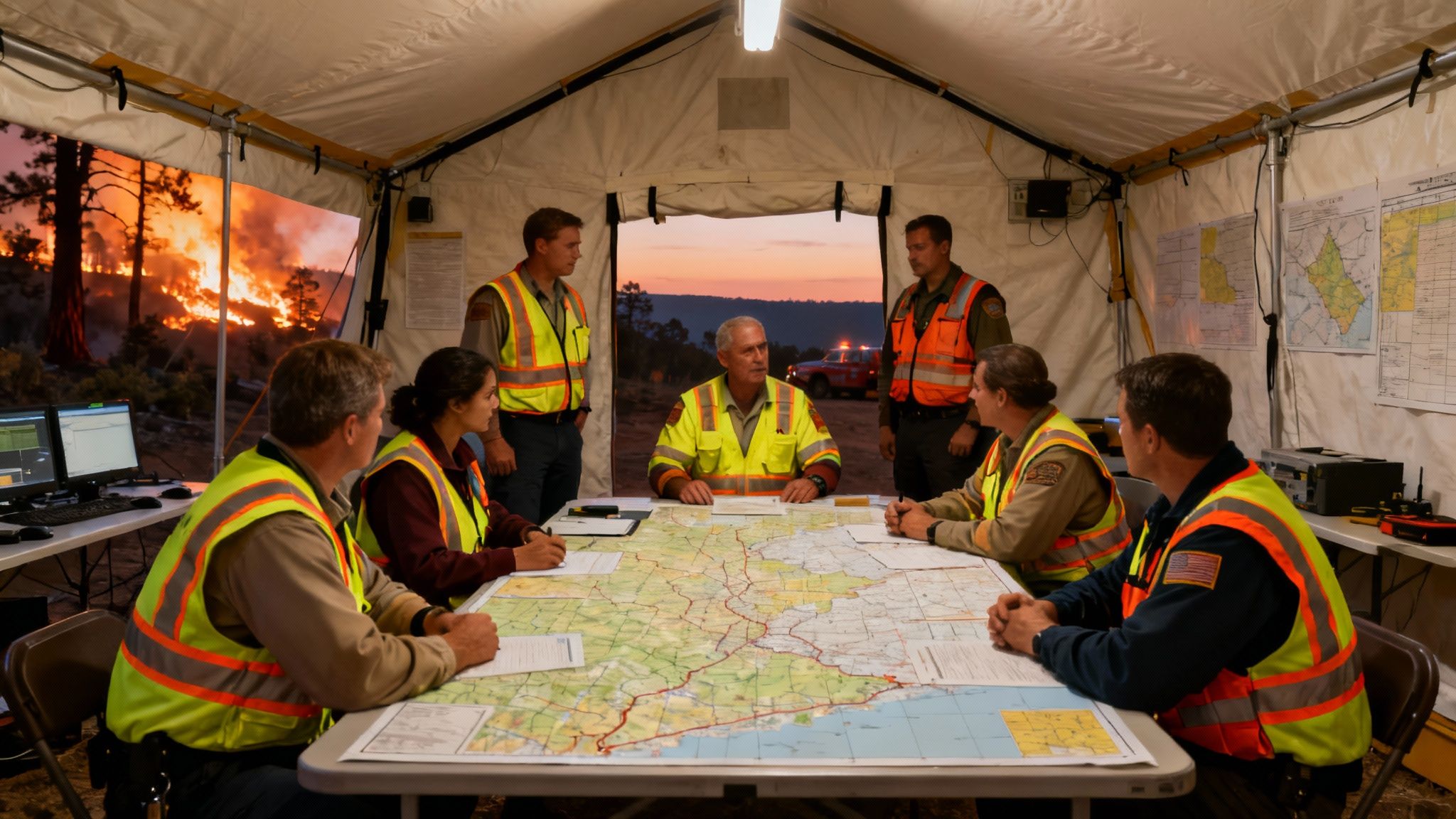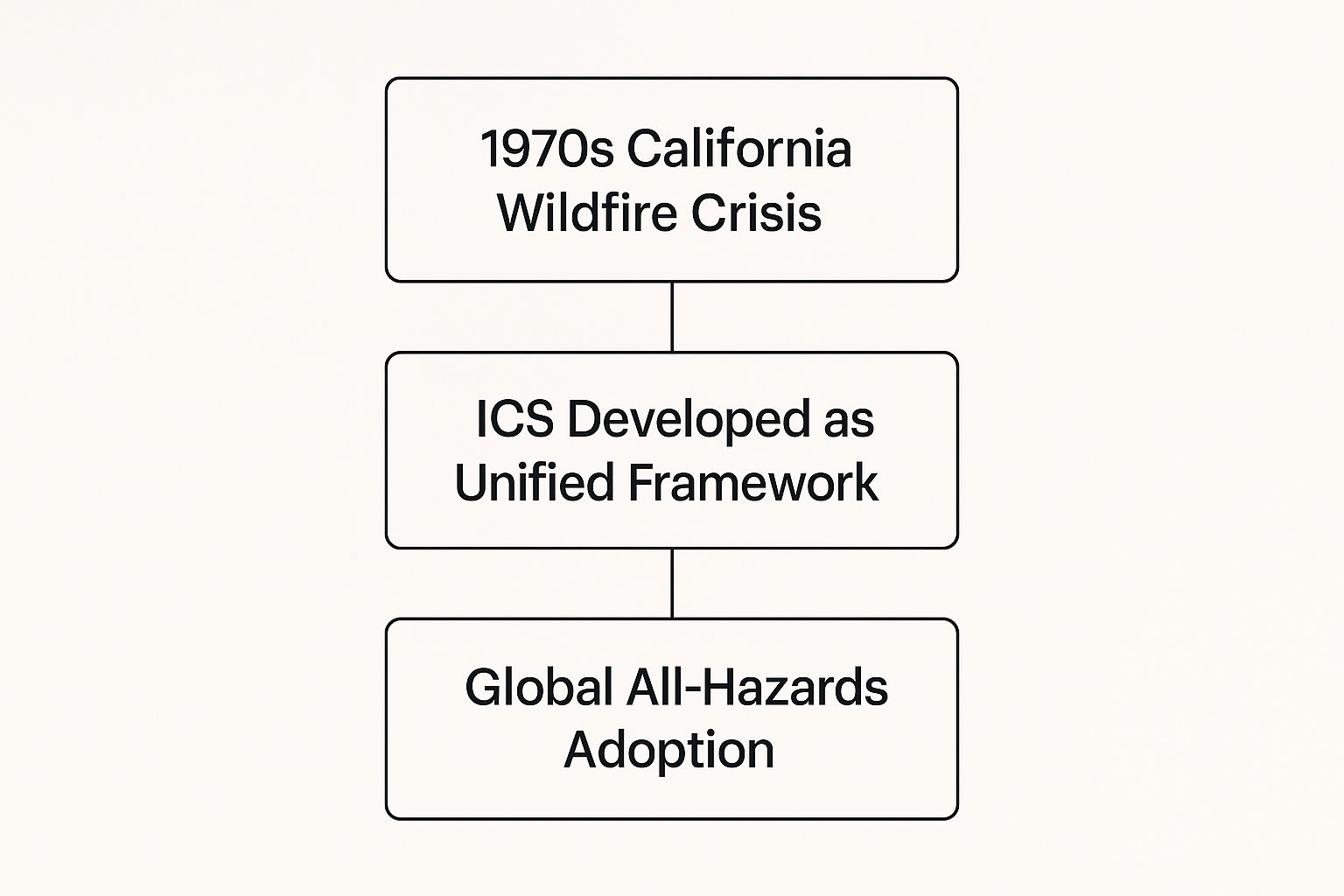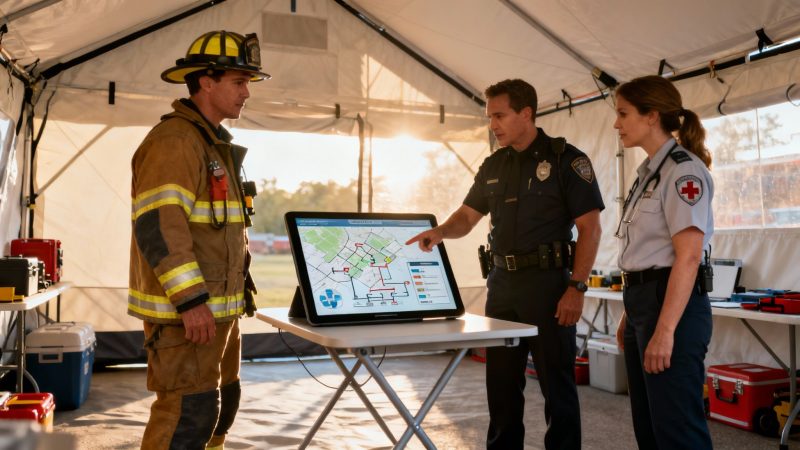What Is Incident Command System? A Practical Guide
When you hear "Incident Command System," or ICS, what comes to mind? For many, it's a formal, almost rigid-sounding term. But at its core, ICS is just a smart, standardized way for emergency responders to organize themselves when things go sideways. It gives everyone—from firefighters and police to paramedics and public works—a common language and a shared playbook to work from during a crisis.
Understanding The Incident Command System In Minutes
Let's paint a picture. A tanker truck overturns on a busy highway, spilling a hazardous chemical. Without a system like ICS, you'd have chaos. The fire department might be focused on the spill, the police on traffic control, and medics on potential injuries. Everyone is working hard, but they're not necessarily working together. Orders could conflict, radio channels could get jammed, and crucial information could fall through the cracks.
This is exactly the problem ICS was designed to solve. It creates a temporary, on-the-fly organizational structure right at the scene. Suddenly, everyone knows who's in charge, what the objectives are, and how their specific role fits into the bigger picture.

The real beauty of ICS is its flexibility. It's not a one-size-fits-all solution. It can scale up or down to meet the demands of any incident. A minor two-car accident might only need a single Incident Commander to manage the scene. But if that same accident involves a fuel leak near a waterway, the ICS structure can instantly expand to bring in Operations, Planning, and Logistics chiefs without missing a beat.
The Five Core Functions of ICS
So, what makes ICS tick? The whole system is built around five fundamental management functions. Think of them as the essential pillars that support any successful response. Each one has a distinct job, ensuring nothing gets overlooked, from putting boots on the ground to tracking every penny spent.
Here’s a quick breakdown of how these roles work together.
The Five Core Functions of ICS
| Function | Core Responsibility | Practical Example (Building Fire) |
|---|---|---|
| Command | Sets the big-picture goals and priorities. This is where the buck stops, led by the Incident Commander who has ultimate authority over the scene. | Establishes the primary goals: "Save lives, stabilize the incident, protect property." |
| Operations | These are the "doers." They carry out the tactical work—fighting the fire, rescuing victims, or controlling the hazard. It’s where the action happens. | Firefighters entering the building to attack the fire and search for occupants. |
| Planning | The "thinkers." They collect and analyze information, track resources, and develop the formal Incident Action Plan (IAP) to guide the next operational period. | Gathers building blueprints, tracks available engine companies, and plans the next steps. |
| Logistics | The "getters." They find and provide all the resources needed for the response, from radios and rescue tools to food, water, and shelter for the responders. | Arranges for a fresh supply of air bottles for firefighters and sets up a rehab area with water. |
| Finance/Admin | The "payers." They handle all the money matters—tracking costs, managing contracts, and handling injury claims. They're essential for budget control and reimbursement. | Documents personnel overtime hours and the cost of specialized foam used to fight the fire. |
These five functions form the backbone of any response, ensuring a coordinated and effective effort from start to finish.
Actionable Insight to Save Money: One of the smartest things you can do is activate the Finance/Admin function right away, even on what seems like a small incident. Why? Because they start meticulously tracking every cost from minute one—personnel hours, equipment usage, supplies, you name it. This detailed documentation is absolutely critical for getting federal reimbursements from agencies like FEMA later. Without it, you could be leaving thousands, or even millions, of dollars on the table.
Why Was the Incident Command System Created
To really get what the Incident Command System is all about, you first have to picture the chaos it was designed to fix. Think about a massive wildfire chewing through thousands of acres. You’ve got multiple fire departments, state agencies, and local police all showing up. Without a shared playbook, who's in charge? Whose radio can even talk to anyone else's? This isn't a hypothetical—it's exactly what happened during a string of devastating California wildfires back in the 1970s.
Response efforts were an absolute mess, hamstrung by a total lack of coordination. Different agencies were using their own lingo, chasing conflicting goals, and operating without anything close to a clear chain of command. The fallout was predictable: wasted resources, critical communication failures, and, tragically, preventable losses of property and life. The crisis made one thing painfully obvious: they needed a completely new way of doing things.
From Wildfire Chaos to a Unified Framework
Born from the ashes of that crisis, the Incident Command System (ICS) was developed as a standardized, common-sense framework for managing emergencies. The whole point was to make sure responders from different agencies and jurisdictions could plug into a single, organized structure without missing a beat. This meant creating a common language, a clear leadership hierarchy, and unified objectives for every single person on scene.
And it worked. The system was so effective that it quickly proved its worth far beyond the fire line. What started as a tool for fighting wildfires grew into a battle-tested solution for all hazards. Its flexible, modular design made it perfect for managing everything from floods and earthquakes to massive public events.
The graphic below shows just how far ICS has come, from a regional fix to a global standard.

This visual journey really drives home how a solution born from a specific disaster became the gold standard for emergency management around the world.
Actionable Insight to Save Money: The real power of ICS, even back then, was its knack for stopping resource duplication. Before ICS, it was pretty common for two different agencies to order the same expensive equipment, completely unaware the other had already done it. By creating a single Logistics section, ICS ensures resources are ordered once and shared efficiently. That directly cuts operational waste and saves a ton of taxpayer money during a crisis.
The framework’s adoption took off. By 1987, the California Department of Forestry (CDF) was all in, creating dedicated command teams to handle incidents that were just too big for local departments to manage alone. Over the next dozen years, these teams managed hundreds of major events, tackling wildfires, floods, and hazmat spills across the U.S. and even internationally. You can dive deeper into the history and use of these specialized teams in the official U.S. Fire Administration report.
Decoding the ICS Structure and Key Roles
To really get what the Incident Command System is all about, you have to look at its engine—the five core management functions that bring order to any chaotic scene. It's like having a blueprint for a pop-up organization, where every department has a crystal-clear purpose.
This structure is designed to be modular. That means it can scale up for a massive event or shrink down for a minor one, making sure every job is covered and no resources go to waste.
Let's walk through a practical example to make this stick. Imagine a chemical spill at a manufacturing plant. This kind of situation demands a fast, coordinated response, making it a perfect scenario to see the ICS roles in action.

The Command Staff: The Decision Makers
Right at the top, you have the Command function. This isn't management by committee; it's a single, clear point of authority.
The Incident Commander (IC) holds the ultimate responsibility for the entire operation. In our chemical spill, the first fire captain to arrive would likely step into this role. They'd immediately set the big-picture objectives, like "ensure public safety" and "contain the spill." The IC doesn't get bogged down in the weeds—they set the strategy and give the final approval on the plan.
Practical Example: During a major flood, the IC would not personally direct individual water rescue boats. Instead, they would set the priority, such as "Evacuate the hospital first," and then empower the Operations Section to figure out the best way to do it.
The Command Staff also includes a few crucial support roles:
- Public Information Officer (PIO): This is your communications chief. They handle all contact with the media and the public, making sure accurate and timely information gets out.
- Safety Officer: This person has one job and one job only: to monitor the scene for hazards and stop any unsafe actions. Their focus is protecting the responders.
- Liaison Officer: This individual is the main point of contact for other agencies and organizations that aren't directly plugged into the command structure.
The General Staff: The Four Pillars
Reporting directly to the IC are four sections that carry out the strategy. Each is led by a "Chief," and this simple hierarchy keeps communication flowing and the response moving forward.
1. Operations Section: The Doers
The Operations Section Chief takes the IC's strategy and puts it into tactical action. These are the folks with boots on the ground, on the front lines of the incident.
- Practical Example: Back at the chemical spill, the Operations team would be the hazmat crews in full gear, physically stopping the leak. It's the firefighters setting up decontamination lines and the police officers evacuating nearby buildings. They are 100% focused on the hands-on work.
2. Planning Section: The Thinkers
While Operations is busy doing, the Planning Section is busy thinking. They're the intelligence hub, gathering information, keeping tabs on resources, and figuring out what's likely to happen next.
- Practical Example: The Planning Chief would be digging up data on the specific chemical involved, checking weather reports to predict where the plume might drift, and putting together the formal Incident Action Plan (IAP) for the next 12-hour operational period. They literally create the roadmap for the entire response.
3. Logistics Section: The Getters
An emergency response grinds to a halt without supplies. The Logistics Section is responsible for getting every single thing the responders need, from people and equipment to food and shelter.
- Practical Example: For our spill, Logistics would be hunting down specialized containment booms, ordering more personal protective equipment (PPE), and arranging for food and water. They'd also be setting up a communications network with extra radios. If you need it, Logistics finds it.
4. Finance and Administration Section: The Payers
Every incident costs money, and this section keeps track of it all. They handle contracts, process any injury claims, and document every single expense.
- Actionable Insight to Save Money: Getting the Finance/Admin Section up and running immediately is a huge cost-saving move. By meticulously tracking personnel hours and equipment use from the very beginning, they build an airtight financial record. This documentation is absolutely critical for getting reimbursed from state or federal agencies later, ensuring your organization recovers every possible dollar.
The Core Principles That Make ICS Work
The real magic of the Incident Command System isn't the org chart—it's the handful of core principles that drive every decision. These aren't just rules written in a dusty manual; they are the DNA of an effective response. This is the secret sauce that takes a chaotic mix of different agencies and forges them into a single, focused team.
These principles are designed to create absolute clarity in the middle of a high-stress, high-stakes situation. They make sure everyone is reading from the same playbook and chasing the same goals. Without them, even the most detailed plan can unravel when the pressure is on.
Unity and Chain of Command
One of the most foundational principles is Unity of Command. In plain terms, it means every single person on an incident answers to only one supervisor.
Think about it. Imagine a firefighter getting conflicting orders from two different bosses—one says "get on the roof and cut a hole," while the other says "get inside and attack the fire." That kind of confusion doesn't just slow things down; it gets people hurt. Unity of Command kills that risk by giving every individual one clear reporting line.
This flows right into a clear Chain of Command, which is simply the line of authority within the ICS structure. It ensures orders and information move smoothly up and down the ladder without skipping steps. This keeps miscommunication from creeping in and makes sure everyone is accountable for their part of the mission.
Manageable Span of Control
Have you ever tried to manage 20 people at once? It’s a recipe for disaster. Nothing gets done effectively. The Incident Command System tackles this head-on with a simple rule: Manageable Span of Control.
This principle says that any supervisor should only have three to seven people reporting directly to them. The sweet spot is five. This simple guardrail prevents any single leader from getting swamped. It ensures they can give clear direction, keep tabs on their team's progress, and, most importantly, look out for their safety.
- Practical Example: At a massive flood, the Operations Section Chief doesn't try to manage 30 separate swift-water rescue teams. That would be impossible. Instead, they'll oversee maybe four or five Branch Directors, and each of those directors will manage a few smaller teams. The workload stays manageable all the way down the line.
Actionable Insight to Save Money: Keeping the span of control in check isn't just about efficiency; it's about money. When supervisors aren't overloaded, they can make much smarter decisions about what their teams actually need. They don't over-order expensive equipment or call for personnel they can't use. This prevents waste and makes sure every dollar is spent where it will do the most good.
Common Terminology and Integrated Communications
When you have multiple agencies working together, this next principle might just be the most important of all: the use of Common Terminology. ICS mandates that everyone uses plain English and standard, pre-defined terms for people, equipment, and locations.
This gets rid of the dangerous confusion that comes from agency-specific slang or ten-codes. A police officer's "10-4" might be meaningless to a paramedic or a public works crew. By sticking to plain language, everyone knows that a "Staging Area" is the same thing, whether you're a firefighter, an EMT, or a volunteer from the Red Cross.
This is all backed up by Integrated Communications, which is just a fancy way of saying there's a single, shared communications plan. It makes sure everyone can actually talk to each other on designated radio channels using agreed-upon procedures. This is the glue that holds a complex operation together, turning potential chaos into coordinated, decisive action.
How Adopting ICS Saves Time and Money
Thinking about the Incident Command System purely in terms of safety and compliance is missing half the picture. It's a strategic financial decision, plain and simple. When chaos hits, it's incredibly easy to mismanage resources and hemorrhage money. ICS brings immediate financial discipline to what would otherwise be a free-for-all.
The very structure of ICS is built to drive efficiency and kill costly redundancies. When every agency shows up and does its own thing, operating in a silo, waste is pretty much a guarantee. A centralized Logistics Section, for example, is the built-in safeguard that stops five different departments from ordering the same high-capacity generator or specialized rescue tools.
Stopping Waste and Maximizing Reimbursement
That coordinated approach means expensive assets are bought once and shared effectively, which directly slashes operational costs on the scene. But the savings don't stop there. The Finance/Administration Section is your best friend when it comes to protecting the bottom line long after the emergency is over.
From the second it’s activated, this section gets to work tracking every single dollar. This isn't a casual accounting exercise; it’s a meticulous documentation effort covering:
- Personnel Costs: Every minute of regular and overtime pay for all responders is logged.
- Equipment Usage: The run-time for every vehicle, pump, or specialty tool is recorded.
- Contracts: Emergency contracts for things like heavy equipment or catering are managed and tracked.
- Supplies: All consumables, from fuel to bandages, are accounted for.
Actionable Insight to Save Money: This detailed documentation is the single most important factor in getting your money back. Without this clear, organized proof of every expense, trying to get reimbursements from agencies like FEMA is a nightmare. You could be left holding a massive, unrecoverable bill. A robust ICS process ensures you capture every reimbursable cost, turning a potential financial disaster into a recoverable event.
A Growing Market for a Reason
This intense focus on efficiency and financial accountability is exactly why the global Incident Command System market is taking off. It was valued at around USD 2.14 billion and is on track to blow past USD 4.8 billion by 2035. That's not just random growth; it’s a worldwide acknowledgment that structured command is non-negotiable for handling modern threats, whether it's a hurricane or a major cyberattack. You can dig into more of the data on the ICS market growth at WiseGuyReports.com.
At the end of the day, investing in ICS training and tools is a proactive move to cut financial losses and reduce liability. By using platforms that are built on ICS principles, you ensure your response is not only effective but also fiscally sound. You can check out the features that support incident management and see how they can fit into your own operations. Adopting ICS means you’re ready to manage both the incident and its financial fallout.
Seeing the Incident Command System in Action
This is where the rubber meets the road. All the theory in the world doesn't mean much until you see how ICS works in a real crisis. While it was born out of the chaos of firefighting, the framework’s real strength is its flexibility. It's now the go-to for managing a huge range of events, both planned and completely unexpected.
From massive public gatherings to complex corporate meltdowns, ICS is what brings order to the chaos.
Super Bowl Security: A Planned Event
Think about the sheer scale of the security operation for something like the Super Bowl. You've got hundreds of agencies involved—local police, fire departments, and federal partners like the FBI and Secret Service—all needing to work as a single, cohesive unit. This is a textbook example of Unified Command in action.
Instead of working in silos, leaders from each agency come together to form one command structure. They share intel and coordinate a single, overarching security plan. The modular nature of ICS lets them spin resources up or down on the fly based on new information, making sure everything from traffic jams to potential threats is handled without a hitch.
Actionable Insight to Save Money: Using a unified approach like this stops communication from breaking down and prevents agencies from tripping over each other for the same resources. This coordinated effort doesn't just keep people safer; it actually saves money by making sure assets are used efficiently instead of being wastefully duplicated. For example, a single Logistics unit can manage all radio cache requests, preventing multiple agencies from renting expensive equipment they don't need.
Healthcare and Corporate Crises
The reach of ICS goes far beyond flashing lights and yellow tape. You’ll find it hard at work in hospitals and corporate boardrooms, too.
Hospitals worldwide use a tailored version called the Hospital Incident Command System (HICS) to handle sudden spikes in patient numbers, like what we all witnessed during the pandemic. Its adoption in so many countries really speaks to how well the core framework can be adapted to highly specialized environments.
It’s the same story in the business world. Imagine a company gets hit with a major cybersecurity breach. They can use ICS principles to stop the bleeding fast. The Chief Information Security Officer (CISO) would likely step in as the Incident Commander, directing different teams:
- Operations: The IT security crew working hands-on to isolate the hacked systems.
- Planning: The threat intelligence team digging into the attack to figure out how it happened and what's next.
- Logistics: The people tasked with bringing in outside forensic experts or new hardware.
This kind of structured response is critical for minimizing downtime and financial damage. It's one thing to read about it, but you really get a feel for how ICS works when you see its impact in critical situations, like how drone operations transforming emergency services. And for any organization looking to formalize this process, dedicated incident management and response apps can make a world of difference.
Common Questions About the Incident Command System

It’s completely normal for organizations to wonder how a system born from firefighting can really apply to their day-to-day world. Let’s tackle a couple of the most common questions we hear.
Is ICS Only for Large Disasters?
Not at all. In fact, thinking ICS is only for massive events is one of the biggest misconceptions out there.
The real power of ICS is its scalability. It’s built to flex. You can use it for something as small as a minor traffic accident or as complex as a multi-state hurricane response. For those smaller incidents, you might just need a single Incident Commander to manage the scene. But as the situation gets more complicated, the modular structure lets you plug in more roles without losing an ounce of control.
Can Businesses Use the Incident Command System?
Absolutely, and many of the smartest ones already do. Businesses are adapting ICS to create their own crisis management plans for everything from cybersecurity breaches and supply chain disruptions to workplace accidents.
It gives them a proven, battle-tested framework to protect people and assets. When a crisis hits, having that organized structure in place is the key to minimizing the financial fallout.
Actionable Insight to Save Money: Imagine a critical supply chain failure. Without an ICS structure, you'd have multiple departments scrambling, all trying to find alternate suppliers. It's a recipe for panicked, decentralized spending where teams end up bidding against each other and driving costs through the roof. With ICS, a single Logistics Section Chief takes charge, sourcing new suppliers efficiently and keeping costs under control.
This structured approach is what ensures you can maintain both operational continuity and financial responsibility, even when things go sideways.
If you run into more specific questions or need a hand applying these concepts to your own team, you can find a ton of great information in the Resgrid support and documentation resources.
Ready to bring order to your operations? With Resgrid, you can implement a clear command structure for any incident, ensuring efficient communication and resource management. Get started today and see the difference a unified platform makes. https://resgrid.com

